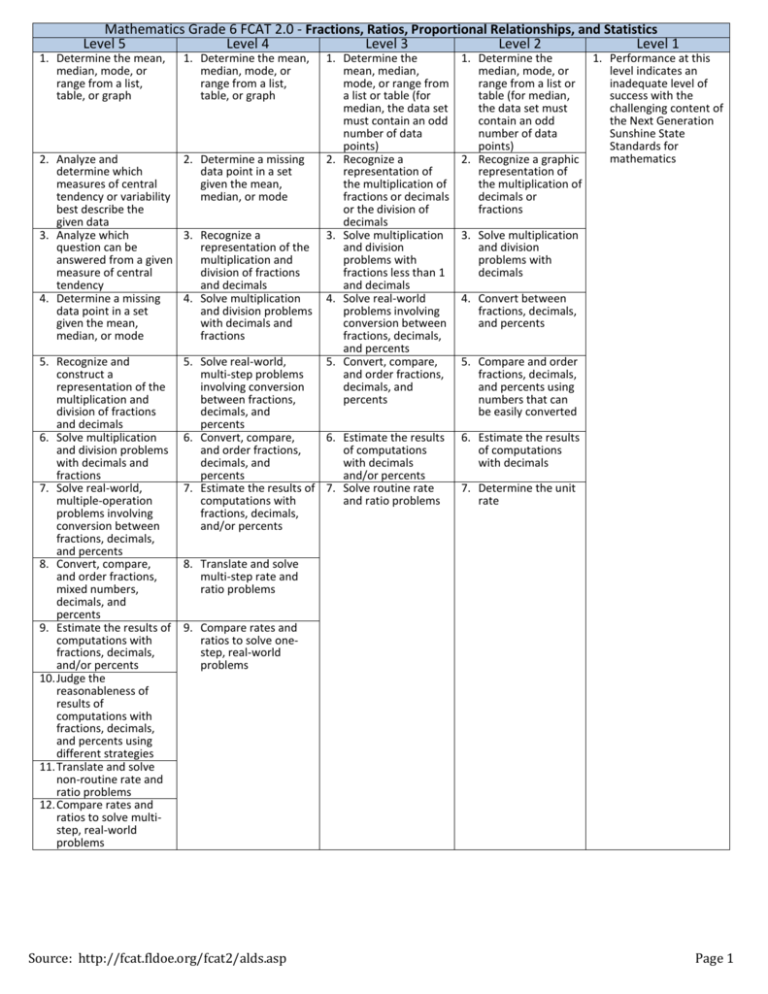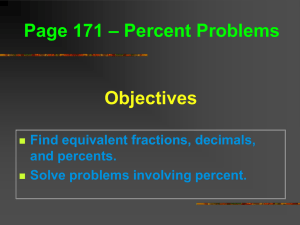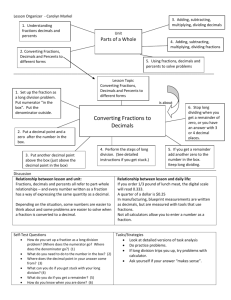Grade 6
advertisement

Mathematics Grade 6 FCAT 2.0 - Fractions, Ratios, Proportional Relationships, and Statistics Level 5 Level 4 Level 3 Level 2 Level 1 1. Determine the mean, median, mode, or range from a list, table, or graph 1. Determine the mean, median, mode, or range from a list, table, or graph 2. Analyze and 2. Determine a missing determine which data point in a set measures of central given the mean, tendency or variability median, or mode best describe the given data 3. Analyze which 3. Recognize a question can be representation of the answered from a given multiplication and measure of central division of fractions tendency and decimals 4. Determine a missing 4. Solve multiplication data point in a set and division problems given the mean, with decimals and median, or mode fractions 5. Recognize and construct a representation of the multiplication and division of fractions and decimals 6. Solve multiplication and division problems with decimals and fractions 7. Solve real-world, multiple-operation problems involving conversion between fractions, decimals, and percents 8. Convert, compare, and order fractions, mixed numbers, decimals, and percents 9. Estimate the results of computations with fractions, decimals, and/or percents 10. Judge the reasonableness of results of computations with fractions, decimals, and percents using different strategies 11. Translate and solve non-routine rate and ratio problems 12. Compare rates and ratios to solve multistep, real-world problems 1. Determine the mean, median, mode, or range from a list or table (for median, the data set must contain an odd number of data points) 2. Recognize a representation of the multiplication of fractions or decimals or the division of decimals 3. Solve multiplication and division problems with fractions less than 1 and decimals 4. Solve real-world problems involving conversion between fractions, decimals, and percents 5. Convert, compare, and order fractions, decimals, and percents 5. Solve real-world, multi-step problems involving conversion between fractions, decimals, and percents 6. Convert, compare, 6. Estimate the results and order fractions, of computations decimals, and with decimals percents and/or percents 7. Estimate the results of 7. Solve routine rate computations with and ratio problems fractions, decimals, and/or percents 1. Determine the 1. Performance at this median, mode, or level indicates an range from a list or inadequate level of table (for median, success with the the data set must challenging content of contain an odd the Next Generation number of data Sunshine State points) Standards for mathematics 2. Recognize a graphic representation of the multiplication of decimals or fractions 3. Solve multiplication and division problems with decimals 4. Convert between fractions, decimals, and percents 5. Compare and order fractions, decimals, and percents using numbers that can be easily converted 6. Estimate the results of computations with decimals 7. Determine the unit rate 8. Translate and solve multi-step rate and ratio problems 9. Compare rates and ratios to solve onestep, real-world problems Source: http://fcat.fldoe.org/fcat2/alds.asp Page 1 Level 5 Mathematics Grade 6 FCAT 2.0 - Expressions and Equations Level 4 Level 3 Level 2 1. Translate and evaluate an expression 1. Translate and evaluate an expression 1. Translate and evaluate an expression where the coefficients and the value of the variables are whole numbers 2. Translate a real-world situation to an equation or inequality 2. Translate a real-world situation to an equation or inequality 3. Solve and graph oneor two-step linear equations or inequalities 4. Identify commutative, associative, identity, inverse, and distributive properties 5. Use the commutative, associative, identity, inverse, or distributive property to show that two expressions are equivalent 6. Identify or construct a table that represents a two-step linear equation 2. Translate a real-world situation to an equation or inequality 3. Solve and graph one- or two-step linear equations or inequalities 4. Identify commutative, associative, identity, inverse, and distributive properties 5. Use the commutative, associative, identity, inverse, or distributive property to show that two expressions are equivalent 6. Identify or construct a table that represents a two-step linear equation 7. Identify or construct a two-step linear equation from a table or graph 8. Analyze a table or graph to identify or describe the rate of change 7. Identify or construct a one-step linear equation from a table or graph 8. Analyze a table or graph to identify or describe the rate of change Source: http://fcat.fldoe.org/fcat2/alds.asp 3. Solve and/or graph one- and two-step linear equations or one-step inequalities 4. Identify commutative, associative, identity, inverse, and distributive properties 5. Use the commutative, associative, identity, or inverse property to show that two expressions are equivalent 1. Evaluate an expression (excluding expressions using the distributive property) where the coefficients and the value of the variables are whole numbers 2. Translate a realworld situation to an equation Level 1 1. Performance at this level indicates an inadequate level of success with the challenging content of the Next Generation Sunshine State Standards for mathematics 3. Solve one-step linear equations or inequalities 4. Identify commutative, associative, identity, inverse, and distributive properties 5. Identify a table that represents a one-step linear equation with whole-number coefficients 6. Identify a table that represents a two-step linear equation with whole number coefficients 7. Identify a one-step linear equation from a table Page 2 Level 5 Mathematics Grade 6 FCAT 2.0 - Geometry and Measurement Level 4 Level 3 Level 2 1. Determine the diameter or radius given the circumference or area of a circle 2. Determine the area or circumference of a circle given a wholenumber radius or diameter 1. Determine the diameter or radius given the circumference of a circle 2. Determine the area or circumference of a circle given a wholenumber radius or diameter 3. Determine the perimeter or area of a composite shape comprised of polygons, semi-circles, and/or circles 3. Determine the perimeter or area of a composite shape comprised of polygons, semicircles, and/or circles 4. Determine a missing dimension given the area of a twodimensional figure or volume of a rectangular prism 4. Determine a missing dimension given the area of a twodimensional figure (rectangle, triangle, or square) or volume of a rectangular prism 5. Determine the volume of a rectangular prism given whole-number dimensions 5. Determine the volume of a rectangular prism given whole-number dimensions Source: http://fcat.fldoe.org/fcat2/alds.asp 1. Determine the area or circumference of a circle given a wholenumber radius or diameter 2. Determine the perimeter or area of a composite shape comprised of polygons given most of the whole-number dimensions 3. Determine a missing dimension given the area of a rectangle or volume of a rectangular prism having wholenumber dimensions 4. Determine the volume of a rectangular prism given whole-number dimensions 1. Determine the circumference of a circle given a wholenumber radius 2. Determine the perimeter of a composite shape comprised of polygons given all of the whole-number dimensions 3. Determine the area of a rectangle or volume of a rectangular prism given whole-number dimensions Level 1 1. Performance at this level indicates an inadequate level of success with the challenging content of the Next Generation Sunshine State Standards for mathematics Page 3







